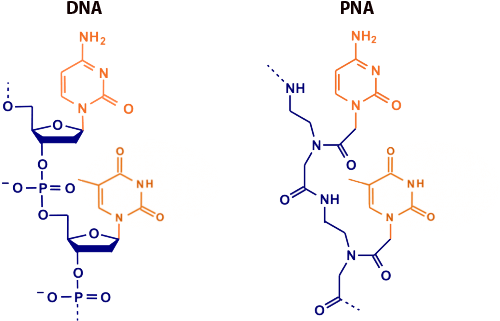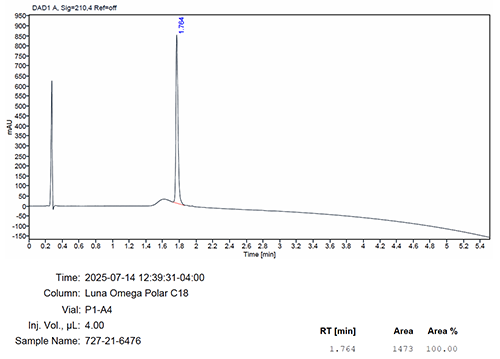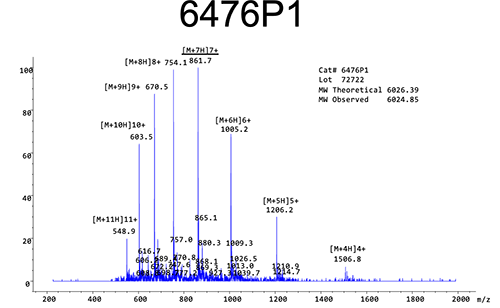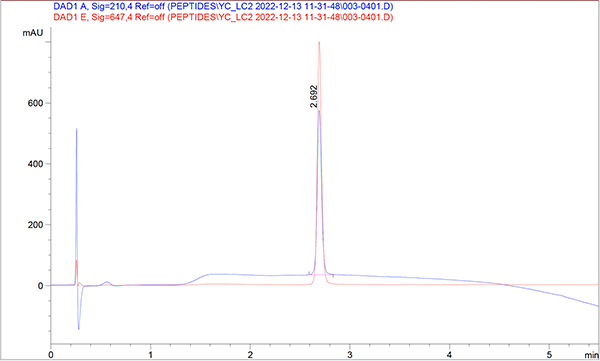
Please click here to get a quote for Peptide Nucleic Acids service now!
Peptide Nucleic Acids (PNAs) 🧬 are synthetic DNA, or RNA mimics that consist of nucleobases attached to a polyamide backbone. PNAs can bind to both DNA and RNA targets in a sequence-specific manner to form PNA/DNA and PNA/RNA duplex structures. The ability of PNAs to sequence-specifically recognize duplex DNA has attracted considerable interest because of their unparalleled ability to invade double-stranded DNA. Besides, PNA confers remarkable resistance to DNases and proteinases. PNA provides a powerful tool to study the mechanism of transcription and an innovative strategy to regulate target gene expression, antisense, antigene agents, molecular probes, 8-17 DNAzyme and 10-23 DNAzyme, Lipid Nanoparticles, and biosensors.
LifeTein provides custom PNA oligos, unlabeled or labeled by fluorescent dyes or other modifications. The PNA oligos can be conjugated to peptides for additional functionality. One example is the Peptide-PNA Conjugate (KFFKFFKFFK-{CTCATACTCT}-NH2). It represents a cutting-edge approach in the fight against multidrug-resistant bacteria.
PNA oligomers can be labeled at 5' and/or 3' end. These labels are available upon request: fluorophores including FAM, FITC, Alexa Fluor dyes, Atto dyes, Cyanine dyes (cy3, cy5, cy7), QSY9, Pyrene, Dylight, quenchers (BHQ, Dabcyl), Acridine, Butyric acid, Alkyne (DBCO or Pentynoic acid), Azide, Biotin, Maleimide, Myristol, Palmitic acid, et al. Contact us if your modification is not on the list.
Featured PNA Products
| PMP01-25 | Peptide nucleotide acid (PNA) PMP01-25: {GGCAAGTCTTCTTCGGA}-NH2 | |
| APP01-25 | Peptide nucleotide acid (PNA) APP01-25: {GGCTCAACTCTGGACAG}-NH2 | |
| EcoPNA1169 | Peptide nucleotide acid (PNA) EcoPNA1169: Biotin - {CAACACACAGTGTC} | |
| LT8195 | (KFF)3K-PNA:KFFKFFKFFK-CTCATACTCT | $1200, 125nmol, In Stock |
| Peptide-Conjugated Antisense PNA for Targeted Gene Silencing | (RXR)4XB-{O}-{gccatttgac} | $950, In Stock |
PNA FISH Probes
| TelC telomere probe | CCCTAACCCTAACCCTAA; Reverse Complementary Sequence (5' to 3'): TTAGGGTTAGGGTTAGGG |
| TelG telomere probe | TTAGGGTTAGGGTTAGGG; Reverse Complementary Sequence (5' to 3'): CCCTAACCCTAACCCTAA |
| Pan-centromere CENPB probe | ATTCGTTGGAAACGGGA; Reverse Complementary Sequence (5' to 3'): TCCCGTTTCCAACGAAT |
| Human only pan-centromere CENT probe | AAACTAGACAGAAGCATT; Reverse Complementary Sequence (5' to 3'): AATGCTTCTGTCTAGTTT |
PNA Applications
The PNA length of 10~30 mer is used for most applications because Tm of PNA is higher than that of DNA. A longer PNA with a high purine content (>60%) can reduce the water solubility. However, we can add additional lysines, O linker AEEA, E linker, or X linker to increase the water solubility. Please avoid the self-complementary sequences such as inverse repeats, hairpin forming, and palindromic sequences because PNA/PNA interaction is stronger than PNA/DNA interaction.
CPP-PNA Examples
CPP |
Sequence |
Pen |
RQIKIWFQNRRMKWKK-PNA |
Tat |
GRKKRRQRRRPPQ-PNA |
47Tat57 |
GGGGYGRKKRRQRRR-PNA |
Cationic |
KKKK-PNA |
Lys |
K-PNA-KKK |
Arg |
RRRRRRRR-PNA |
H region |
AAVALLPAVLLALLA-PNA |
PTD-4 |
YARAAARQARA-PNA |
Tp-10 |
AGYLLGKINLKALAALAKKIL-PNA |
SSBP(I) |
PKKKRKV-PNA |
C-myc tag |
EQKLISEEDLNA-PNA |
Tat-modified |
RRRQRRKKR-PNA |
To demonstrate the capabilities of our custom PNA–peptide synthesis service, we present a representative structure that illustrates the complexity and flexibility of our platform. Due to client confidentiality, the full sequence cannot be disclosed, but the following anonymized format captures its essential features:
H‑PKKKRKVKK‑{TxJTxxJJ}‑linker‑{CxxxTCxxxT}‑x‑K(N₃)‑NH₂
Key Features of This ConstructThis structure highlights our ability to:


PNA Case Study
This case study shows a complicated PNA synthesis with a fluorescent Cyanine Dye Cy5 modification at the N terminus, and an azido group at the C terminus for the click chemistry for the downstream reactions.
The sequence of the peptide used is as follows:
Cys(Cy5)-{XXXXXX}-Lys(N3)-NH2, X stands for A, T, G, C monomers, Cyanine Dye Cy5, Fmoc-Lys(N3)-OH (Fmoc-L-azidolysine)) was used for the synthesis. The side-chain azido group is completely stable and can be further selectively modified using Staudinger ligation or Click-chemistry.
